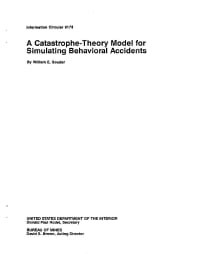Mining Publication: A Catastrophe-Theory Model for Simulating Behavioral Accidents
Original creation date: November 1988
Authors: WE Souder
NIOSHTIC2 Number: 10005986
Pittsburgh, PA: U.S. Department of the Interior, Bureau of Mines, IC 9178, 1986 Nov; :1-19
Behavioral accidents are a particular type of accident. They are caused by inappropriate individual behaviors and faulty reactions. Catastrophe theory is a means for mathematically modeling the dynamic processes that underlie behavioral accidents. Based on a comprehensive data base of mining accidents, a computerized catastrophe model has been developed by the Bureau of Mines. This model systematically links individual psychological, group behavioral, and mine environmental variables with other accident causing factors. It answers several longstanding questions about why some normally safe behaving persons may spontaneously engage in unsafe acts that have high risks of serious injury. Field tests with the model indicate that it has three important uses: It can be used as an effective training aid for increasing employee safety consciousness; it can be used as a management laboratory for testing decision alternatives and policies; and it can be used to help design the most effective work teams.

NIOSHTIC2 Number: 10005986
Pittsburgh, PA: U.S. Department of the Interior, Bureau of Mines, IC 9178, 1986 Nov; :1-19
- Degasification System Selection for U.S. Longwall Mines Using an Expert Classification System
- Effects of Weak Bands on Pillar Stability in Stone Mines: Field Observations and Numerical Model Assessment
- Elastic and Shear Moduli of Coal Measure Rocks Derived from Basic Well Logs Using Fractal Statistics and Radial Basis Functions
- Emergency Escape and Refuge Alternatives
- Major Disasters at Metal and Nonmetal Mines and Quarries in the United States (Excluding Coal Mines)
- Pillar Strength and Design Methodology for Stone Mines
- Refuge Alternatives in Underground Coal Mines
- Stochastic Modeling of Gob Gas Venthole Production Performances in Active and Completed Longwall Panels of Coal Mines
- Technology News 497 - "You Are My Sunshine": A New Video Release From NIOSH on the Sunshine Mine Fire
- Underground Coal Mine Disasters 1900-2010: Events, Responses, and a Look to the Future